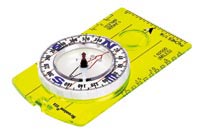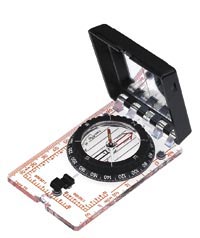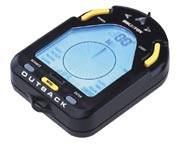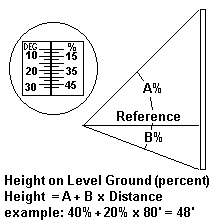Please feel free to check out our line of Brunton Products These models are made by both Brunton and Silva. You can order any of these models from us.
Please Email Us For Any Information.
A Word On Compass
Principals
The basic form of compass has been used for navigation for
over 2000 years. It has been discovered that a free mounted
magnet will point relative to the earth's poles, thus giving
a reliable indication of direction. Over the years this
technique has been improved upon to the point where precision
compasses are being made for all imaginable situations where
a reference of direction is required. A compass can also be
used to measure the distance
of an object or point from you.
A typical compass needle is made with a free mounted strong light weight magnet sitting on a precision jeweled bearing or similar mount. This is to allow it to be sensitive enough to point to the direction of the source of the earth's magnetic field.
To dampen the movement of the needle so that it
will not easily wobble and be stable when held, it is
submerged into a liquid. This liquid is usually a petroleum
based liquid. There are many compasses that use no liquid in
their inclosure, but have other methods of damping. One
method is to have the needle sitting near to a conductive
metal ring around its parameter. When the compass needle is
swinging, it generates a very small eddy current into the
metal ring, thus giving a breaking effect to rapid movement.
The current generation is actually in the picoamp range, but
the needle is dampened by it because of its low mass. 
In different parts of the world there is a small error in the compass bearing readings. This is known as magnetic declination. There is Eastern and Western declination depending on your location in respect to the earth's magnetic field reference. For example in North America, in the Eastern part, the declination error is Western. In the West, the declination is Eastern. The navigational maps and charts for your area should have this declination error printed on them. The local weather office, airport traffic services, or forestry and ranger services should also have this information for your area.
When using a compass it is very important that the declination error is taken in account when taking readings for proceeding on a particular route or track. If for example you are in an area where the declination is West by 16 degrees, This means that you must add 16 degrees to the true heading when using a compass to make your track. For example if you want to take a true heading of 270 degrees West from your starting point, you will have to steer or track 270 plus 16 degrees in the magnetic or compass reading. This is for a declination of 16 degrees West. For an Eastern declination, this would be the opposite.
There are many types of compasses available for
many types of applications. For most people who are wanting
to do some basic exploration or hiking, a simple low cost one
would  be
a good investment. It must however be a dependable unit that
can take reliable readings. For most basic applications a
reading of better than 5 degrees is adequate. When out
tracking, you should be checking for corrections at each
preplanned checkpoint or landmark along your route. Most of
the compasses for basic recreation are accurate to better
than 2 degrees.
be
a good investment. It must however be a dependable unit that
can take reliable readings. For most basic applications a
reading of better than 5 degrees is adequate. When out
tracking, you should be checking for corrections at each
preplanned checkpoint or landmark along your route. Most of
the compasses for basic recreation are accurate to better
than 2 degrees.
For more precision work such as mining, engineering, and advanced exploration, there are precision compasses available that can take very accurate readings to better than 1 degree. For such accuracy the price will climb very rapidly.
Taking Care
Of A Compass
When storing a compass, you must take care not to expose it
to a magnetic field such as from speakers, computers, and
other electrical or electronic devices. For example, storing
a compass in the glove box, or on the dash of a car would not
be recommended. There are usually speakers, and electrical
wiring located near these areas. If you put a compass in your
pocket make sure that it is not near to a cell phone, scanner,
or pocket radio. The speaker in these units can wrongly re-magnetize
the needle. Storing a compass in a hot car can also damage it
because the liquid inside may expand, thus rupturing the seal
and start leaking. There may be some air bubbles formed
inside thus impeding the performance of the compass.
If you want a compass to store in a car, you
should get one that is designed to take very warm storage
temperatures, or not use a damping liquid inside.
Safety With
Your Compass
Before using your compass for serious business it is wise to
take some readings of some known headings to verify that it
is working correctly. Many serious explorers also take at
least one backup compass. This is in case the main one gets
lost, or smashed. If you are out in dense  country,
or in bad weather this would be advisable.
country,
or in bad weather this would be advisable.
Using Your
Compass With A G.P.S.
When using a G.P.S., it is very wise to take a compass along.
The G.P.S. batteries can die, or the unit can fail. A compass
does not require any batteries or has any sensitive
electronics in it. A G.P.S. normally will not give a bearing
from your stationary point. You will need to use a compass
for that in any case. For the G.P.S. to give a track reading,
you must be moving at a steady pace with it. In dense bush or
harsh country this may not be so practical to do. A G.P.S.
should be used as a precision reference only. You should
always keep track of what is going on with your compass, maps,
and charts. There are electronic compasses as well. These can
fall into the same predicament as a G.P.S.
A G.P.S. is very good for marking landmarks for
good fishing spots, campsites, on track storage  areas,
and other required references. A manual marking on your map
would also be advisable as well. The standard available G.P.S.
to the public (non military) is only accurate to about 100
feet. With a good detailed map or chart, and compass you can
probably get a better accuracy than that. The G.P.S. accuracy
of 100 feet is a restriction from the US Government services.
This is known as Selective Availability or S.A. The user
manual for your G.P.S. should have details about S.A.
areas,
and other required references. A manual marking on your map
would also be advisable as well. The standard available G.P.S.
to the public (non military) is only accurate to about 100
feet. With a good detailed map or chart, and compass you can
probably get a better accuracy than that. The G.P.S. accuracy
of 100 feet is a restriction from the US Government services.
This is known as Selective Availability or S.A. The user
manual for your G.P.S. should have details about S.A.
Distance
Clinometers

The Clinometer is a device that shows a scale for measuring
the height of a vertical standing object, or its distance
from you. It has a scale on its card that is in degrees or
angular percentage, or both. Some compasses come with this
type of scale built in. A separate Clinometer can also be
obtained specifically for this purpose. An example of a
typical height measurement is shown here.
If you know the distance of a particular object, the height of it may be determined by taking the total angular sum in its percentage value from its base to its top, and multiplying it by the distance value. For example if the sum of the total angular percentage from its base to its top is 60% and the distance is 80 feet, then the height is 48 feet. (0.60 x 80) = 48. (The angular percentage is in relation to the tangent of the angle in degrees). Angular percentage is also known as percent Grade (%G).
Please also see Measuring Distance With A
Compass
![]() Please note that the graphic
shown here is for demonstration only, and is not calibrated
to scale.
Please note that the graphic
shown here is for demonstration only, and is not calibrated
to scale.
Where To See Quality Compasses And Products
 from
us. We also handle a line of very good quality optics.
from
us. We also handle a line of very good quality optics.
